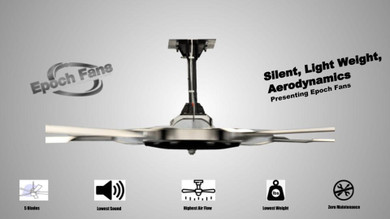Air Flow
It is also called air supply or air delivery. This is something for which we usually buy HVLS Fans. However, we often don’t know the basic factors that determine the airflow and efficiency of the HVLS fan. In fact, the quantity of air that the HVLS fan moves every minute directly affects its level of efficiency.
For obvious reasons, the motor forms the primary factor that determines the fan's power, efficiency, and durability. In addition to the motor, there are some other factors that work perfectly to define the industrial fan's efficiency and air distribution. These factors along with your budget, personal preferences, and requirements can help you to choose the right industrial ceiling fan for your space.
Check out the below points that can help you to determine the air delivery of an industrial ceiling fan.
Blade pitch
The blade pitch basically refers to the angle at which the blades are aligned to the ground. In the world of fans, it says "the stepper blade moves the air as much as the fan." As a standard, the optimal blade pitch for an industrial ceiling fan is between 12 and 15 degrees. For better understanding, you need to know that the fan blades with relatively flat pitch (between 10 and 12 degrees) don’t require very large motors to reach high speeds, whereas stepper blades have a pitch about 14 to 15 degrees and this requires the powerful motor to achieve the same speed. Thus, for the best performance and airflow, the power of the motor and blade pitch must complement each other.
RPM
The RPM stands for “revolutions per minute”. In the terminology of fans, RPM indicates how fast the blades rotate at a certain speed.The faster the blades move, the more airflow it gives, but the blades should support the right pitch angle.To increase airflow and to achieve maximum air distribution, the fan should consist of different speed settings (low to high speed). At the same time, one should note that faster rotation provides higher airflow distribution, but it also increases the noise levels and could be unbearable after a certain level.
Height from Floor
To offer the best airflow, the height from floor to the HVLS fans must be approximately in the ratio of 1.5D~H (Where D is fan diameter and H is the height from the floor). In case, your HVLS fans are too close or too far from the floor, it won’t move as much air as it should offer.
Example: Let us say height, H from ceiling to floor is 27 feet, if we left 3 feet for the fan mounting, the net height remains 24 feet then,
D ~ H/1.5 = 24/1.5
D ~ 16 Ft
From the above example, we understand that if the total height is 27 feet, then there should be a fan of 16 feet in diameter for perfect airflow.
Motor Power
In addition to the above-mentioned factors, the most important factor is the motor power of the HVLS fan. However, all components need to work in alignment with each other for the best results. As a rule, powerful motors are best considered to provide maximum airflow, comfort, and durability. The EPOCH HVLS high-performance motor-powered fans will provide the best return on investment and more for a lifetime.
Once we are able to understand the factors that influence the performance and efficiency of HVLS fans, its easy to make decisions to select the right HVLS fan. Epoch HVLS fans have the best range for HVLS fans which has numerous advantages. Falco eMotors manufacture the Epoch HVLS fans which have been developed using the latest technology, accurate blade pitch angle and highest RPM in the class. The Permanent Magnet Synchronous Motor (PMSM) is used in HVLS fans and is fully innovated with zero sound and maintenance. It is a direct-drive motor. Hence it reduces gearbox and maintenance costs in addition to power consumption.
If you are interested to buy Epoch HVLS Fans, please visit our website or contact us through the email given below.

